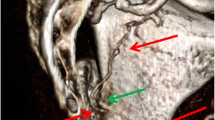Abstract
The aim of this study was to establish a 3D digitized model of pelvic vasculature for anatomic study, preoperative planning, and virtual reality. Three adult fresh cadavers were perfused with carboxymethyl cellulose/lead oxide mixture to mark blood vessels, and subjected to multilayer spiral computed tomography scanning to obtain a series of thin sections. Then, the 2D images of the pelvis and pelvic blood vessels were transformed into 3D digitized models using Mimics 11.0. The 2D images of carboxymethyl cellulose/lead oxide filled arteries had the features of entire outline and few constructed defects. The 3D digitized models of the pelvis and pelvic artery system displayed spatial location and the adjacent relationship of arteries with the pelvis. Not only the well-known arteries but also the tiny blood vessels in the reconstructed structures were well demonstrated and observed interactively. The reconstructed tissue flaps, including a lobulated skin flap with the pedicel of superficial epigastric artery, and an iliac flap with the pedicel of deep iliac circumflex artery, demonstrated their blood supply area. This indicated that the modified technique of vascular perfusion with carboxymethyl cellulose/lead oxide and reconstitution with Mimics 11.0 software contributed to 3D digitized model of pelvic vasculature.



Similar content being viewed by others
References
Bergeron L, Tang M, Morris SF (2006) A review of vascular injection techniques for the study of perforator flaps. Plast Reconstr Surg 117:2050–2057
Bergeron L, Tang M, Morris SF (2007) The anatomical basis of the deep circumflex iliac artery perforator flap with iliac crest. Plast Reconstr Surg 120:252–258
Dijck JV (2000) Digital cadavers: the visible human project as anatomical theater. Stud Hist Philos Sci 31:271–285
Ebbers T, Wigstrom L, Bolger AF et al (2002) Noninvasive measurement of time-varying three-dimensional relative pressure fields within the human heart. J Biomech Eng 124:288–293
Elliot KF, Derek RN, David G et al (2005) Volume rendering versus maximum intensity projection in CT angiography: what works best, when, and why. Radiographics 26:905–922
Gao CJ, Xu DC, Pei Q, Yuan XJ (2006) Pelvic artery representation on three-dimensional reconstructed multislice spiral CT images: variability between the young and the elderly. Nan Fang Yi Ke Da Xue Xue Bao 26(5):670–673. (inChinese)
Gemery JM, Nangia AK, Mamourian AC, Reid SK (2007) Digital three-dimensional modelling of the male pelvis and bicycle seats: impact of rider position and seat design on potential penile hypoxia and erectile dysfunction. BJU Int 99(1):135–140
Guo YL, Heng PA, Zhang SX et al (2005) Thin sectional anatomy, three-dimensional reconstruction and visualization of the heart from the Chinese Visible Human. Surg Radiol Anat 27:113–118
Heng PA, Zhang SX, Xie YM et al (2006) Photorealistic virtual anatomy based on Chinese Visible Human data. Clin Anat 19(3):232–239
Heymans OY, Nélissen XP, Peters S, Lemaire V, Carlier (2004) A new approach to vascular injection in fresh cadaver dissection J Reconstr Microsurg 20(4):311–315
Neal CD, Srinivasa RP, Michael WF et al (2005) Introduction to the language of three-dimensional imaging with multidetector CT. RadioGraphics 25:1409–1428
Otcenasek M, Krofta L, Baca V et al (2007) Bilateral avulsion of the puborectal muscle: magnetic resonance imaging-based three-dimensional reconstruction and comparison with a model of a healthy nulliparous woman. Ultrasound Obstet Gynecol 29(6):692–696
Rees MJ, Taylor GI (1986) A simplified lead oxide cadaver injection technique. Plast Reconstr Surg 77:141–145
Uhl JF, Park JS, Chung MS et al (2006) Three-dimensional reconstruction of urogenital tract from visible Korean human. Anat Rec A Discov Mol Cell Evol Biol 288(8):893–899
Venuti JM, Imieliel C, Molholt P (2004) New views of male pelvic anatomy: role of computer-generated 3D Images. Clin Anat 17:261–271
Watanabe Y, Ikegami R, Takasu K et al (2005) Three-dimensional computed tomographic images of pelvic muscle in anorectal malformations. J Pediatr Surg 40(12):1931–1934
Yiming A, Baque P, Rahili A et al (2002) Anatomical study of the blood supply of the coxal bone: radiological and clinical application. Surg Radiol Anat 24:81–86
Zhang SX, Liu ZJ (2006) Chinese visible human project. Clin Anat 19:204–215
Author information
Authors and Affiliations
Corresponding author
Rights and permissions
About this article
Cite this article
Ding, HM., Yin, ZX., Zhou, XB. et al. Three-dimensional visualization of pelvic vascularity. Surg Radiol Anat 30, 437–442 (2008). https://doi.org/10.1007/s00276-008-0348-z
Received:
Accepted:
Published:
Issue Date:
DOI: https://doi.org/10.1007/s00276-008-0348-z




